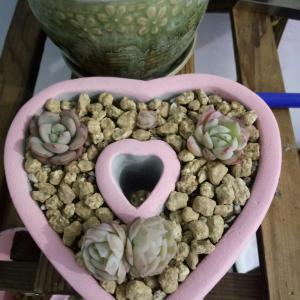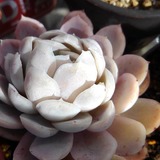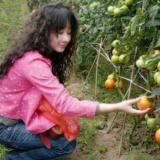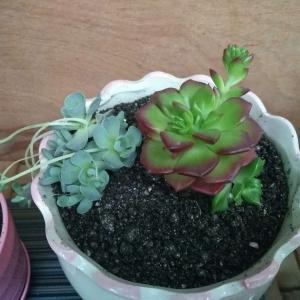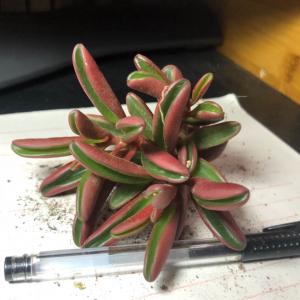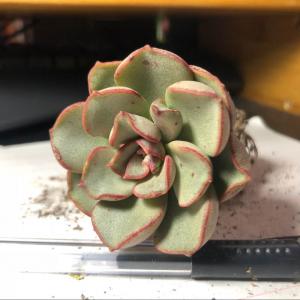文章
Miss Chen
2018年03月29日

Description: This perennial plant is sparsely branched and up to 2½' tall. The stems have fine white hairs. The alternate compound leaves are trifoliate and have slender primary petioles about ¼–¾" long. The leaflets are up to 1½" long and ½" across. They have smooth margins and are oblong, except for a tiny point at the tip.

The flowers occur in crowded heads on short peduncles in the upper portions of the stems. The lower flowers are cleistogamous and inconspicuous; they are capable of forming fertile seeds without the pollination of insects. The upper flowers are about ¼" across and have a typical pea-like structure. This consists of a broad upper petal, and two smaller side petals that parallel a jutting lower lip. The petals of these flowers are pink, although the base of the upper petal is rose pink. These flowers remain clustered along the stems amid the leaves. The blooming period is late summer or early fall, and lasts about 3 weeks. There is no floral scent. The root system consists of a deep taproot.
Cultivation: The preference is full or partial sun, and mesic to dry conditions. This plant grows readily in soil that is loamy, rocky, or sandy. It has excellent drought resistance. It's easy to start plants from seeds or transplants, and foliar disease is rarely troublesome. Soil with below average pH is tolerated, if not actually preferred. Sometimes this plant has trouble competing against taller, more aggressive plants in fertile soil.
Range & Habitat: The native Slender Bush Clover is occasional in the southwestern section of Illinois, but it is uncommon or absent elsewhere (see Distribution Map). Habitats include drier areas of black soil and sandy prairies, hill prairies, rocky upland forests and sandy forests, savannas and sandy savannas, scrubby barrens with poor soil, limestone glades, bluffs, and banks along lakes. The woodland areas where this plant occurs are often dominated by oak trees.

Faunal Associations: The flowers are visited by long-tongued bees, short-tongued bees, flies, small butterflies, and skippers. These insects seek nectar, although the bees also collect pollen. Among these visitors, bees are probably the most effective pollinators of the flowers. The caterpillars of some species of skippers feed on the foliage, including Thorybes bathyllus (Southern Cloudywing), Thorybes pylades (Northern Cloudywing), and Achalarus lyciades (Hoary Edge). The seeds are eaten by some upland gamebirds, particularly the Bobwhite, and occasionally the Wild Turkey. Mammalian herbivores of all kinds readily feed on Slender Bush Clover, including deer, rabbits, groundhogs, and livestock. An overpopulation of these animals can make the establishment of this plant difficult in some areas.
Photographic Location: The photograph was taken at the webmaster's wildflower garden in Urbana, Illinois.
Comments: The flowers of Slender Bush Clover are attractive, but small-sized. This plant has a more delicate appearance than Lespedeza capitata (Round-Headed Bush Clover), with greener leaves and pinker flowers.

The flowers occur in crowded heads on short peduncles in the upper portions of the stems. The lower flowers are cleistogamous and inconspicuous; they are capable of forming fertile seeds without the pollination of insects. The upper flowers are about ¼" across and have a typical pea-like structure. This consists of a broad upper petal, and two smaller side petals that parallel a jutting lower lip. The petals of these flowers are pink, although the base of the upper petal is rose pink. These flowers remain clustered along the stems amid the leaves. The blooming period is late summer or early fall, and lasts about 3 weeks. There is no floral scent. The root system consists of a deep taproot.
Cultivation: The preference is full or partial sun, and mesic to dry conditions. This plant grows readily in soil that is loamy, rocky, or sandy. It has excellent drought resistance. It's easy to start plants from seeds or transplants, and foliar disease is rarely troublesome. Soil with below average pH is tolerated, if not actually preferred. Sometimes this plant has trouble competing against taller, more aggressive plants in fertile soil.
Range & Habitat: The native Slender Bush Clover is occasional in the southwestern section of Illinois, but it is uncommon or absent elsewhere (see Distribution Map). Habitats include drier areas of black soil and sandy prairies, hill prairies, rocky upland forests and sandy forests, savannas and sandy savannas, scrubby barrens with poor soil, limestone glades, bluffs, and banks along lakes. The woodland areas where this plant occurs are often dominated by oak trees.

Faunal Associations: The flowers are visited by long-tongued bees, short-tongued bees, flies, small butterflies, and skippers. These insects seek nectar, although the bees also collect pollen. Among these visitors, bees are probably the most effective pollinators of the flowers. The caterpillars of some species of skippers feed on the foliage, including Thorybes bathyllus (Southern Cloudywing), Thorybes pylades (Northern Cloudywing), and Achalarus lyciades (Hoary Edge). The seeds are eaten by some upland gamebirds, particularly the Bobwhite, and occasionally the Wild Turkey. Mammalian herbivores of all kinds readily feed on Slender Bush Clover, including deer, rabbits, groundhogs, and livestock. An overpopulation of these animals can make the establishment of this plant difficult in some areas.
Photographic Location: The photograph was taken at the webmaster's wildflower garden in Urbana, Illinois.
Comments: The flowers of Slender Bush Clover are attractive, but small-sized. This plant has a more delicate appearance than Lespedeza capitata (Round-Headed Bush Clover), with greener leaves and pinker flowers.
0
0
文章
Miss Chen
2018年03月29日

Description: This herbaceous perennial plant is ½–2' tall or long, branching occasionally. The stems are light green to brown, terete, and sparsely appressed-pubescent; they are erect, ascending, or sprawling. Alternate trifoliate leaves occur along these stems, becoming smaller in size toward the tips or apices of these stems. The leaflets are ½–1½" long and about one-half to one-third as much across; they are oblong-elliptic to broadly oblong-elliptic in shape and their margins are entire (toothless). Usually, the terminal leaflets are slightly larger in size than the lateral leaflets. The upper surface of these leaflets is medium green and hairless to sparsely appressed-pubescent, while the lower surface of these leaflets is light green or whitish green and moderately to densely appressed-pubescent. Leaflet venation is pinnate with prominent central veins and weaker lateral veins; the lateral veins are straight and run parallel to each other. Petioles of trifoliate leaves are ¼–1½" long; they are light green, terete, and sparsely appressed-pubescent. The petiolules (basal stalklets) of the terminal leaflets are 2-5 mm. long, while the petiolules of the lateral leaflets are 0.5–1 mm. long. At the bases of petioles along the stems, there are pairs of small stipules. These stipules are 2-5 mm. long and linear in shape; they have a tendency to wither early.
Leafy Plant with Seedpods
Racemes and/or sparingly branched panicles of 3-8 flowers are produced on long ascending peduncles from either the axils of upper leaves or directly from the upper stems. These peduncles extend beyond the compound leaves. The inflorescences are also produced from the axils of middle leaves, although their peduncles tend to be about as long as the petioles of compound leaves. Each flower is about 6-10 mm. in length, consisting of a light green calyx with 5 teeth, 5 whitish purple to purple petals, 10 stamens, and a pistil with a single style. The flowers have a typical pea-like floral structure, consisting of a large upright banner (upper petal), a pair of wings that are slightly spreading and extend forward (2 lower outer petals), and an inner keel that extends forward (2 lower inner petals). The wings of each flower are slightly shorter than its keel. At the base of the banner, there is an arch-shaped patch of dark rosy purple. The calyx is sparsely appressed pubescent and it extends to about one-half of the length of the flower. The pedicels of the flowers are short (1-4 mm. in length). In addition to the preceding chasmogamous flowers, there are also inconspicuous cleistogamous (self-fertile) flowers that develop from the axils of the leaves. These cleistogamous flowers are held close to the stems on short pedicels (1-4 mm. in length). The blooming period occurs from mid- to late summer, lasting about 1 month.

Afterwards, fertile flowers are replaced by small seedpods that become 4-7 mm. long at maturity, the latter changing in color from green to dark brown. Usually, the chasmogamous flowers don't produce seedpods, while the cleistogamous flowers almost always do. The seedpods are orbicular-ovate in shape and flattened, tapering abruptly at their tips into short beaks; they are sparsely appressed-pubescent along their sides. Each seedpod contains a single reniform (kidney-shaped) seed. The root system consists of a taproot.
Cultivation: The preference is partial sun, dry-mesic conditions, and somewhat sterile soil containing some clay or rocky material. Competition from taller and more aggressive ground vegetation is not well-tolerated. This legume fixes nitrogen in the soil.
Range & Habitat: The native Violet Bush Clover is occasional in the southern half of Illinois, while in the northern half of the state it is uncommon (see Distribution Map). However, it can be found in scattered areas throughout the state. Habitats include upland rocky woodlands, thinly wooded bluffs along rivers, upland savannas, hill prairies, dry grassy openings in upland woodlands, and roadside embankments along hilly woodlands. Violet Bush Clover is found primarily in average to high quality natural areas. It probably benefits from occasional wildfires that reduce competition from woody vegetation.

Faunal Associations: The chasmogamous flowers of Violet Bush Clover are cross-pollinated primarily by bees, including leaf-cutting bees (Megachile spp.), digger bees (Melissodes spp.) and Halictid bees. Small butterflies and skippers may also visit these flowers, but they are less effective at cross-pollination. The showier chasmogamous flowers of Violet Bush Clover probably require insect cross-pollination before they can produce seedpods, while the cleistogamous flowers do not. Miscellaneous insects feed destructively on the foliage, seeds, and other parts of bush clovers (Lespedeza spp.). These insects include the seed-eating larvae of a weevil (Coelocephalapion decoloratum), various leaf beetles and their larvae (Anomoea laticlavia, Odontota horni, Phyllecthris dorsalis, etc.), foliage-eating larvae of a sawfly (Atomacera debilis), seed-eating broad-headed bugs (Alydus spp.), an aphid (Microparsus singularis), the Prairie Walking Stick (Diapheromera velii), and Tick Trefoil Thrips (Neohydatothrips desmodianus); see Sauer (2005), Clark et al. (2004), Smith (2006), Schaefer (1980), Blackman & Eastop (2013), Arment (2006), and Stannard (1968). The caterpillars of some skippers feed on the foliage of bush clovers; these species include the Hoary Edge (Achalarus lyciades), Southern Duskywing (Thorybes bathyllus), and Northern Duskywing (Thorybes pylades). In addition, the larvae of some moths feed on these plants. Examples of such moths include the Bella Moth (Utetheisa bella), Common Ptichodis (Ptichodis herbarum), Black-spotted Prominent (Dasylophia anguina), a Cosmopterigid moth (Triclonella pergandeella), and a Gracillariid moth (Parectopa lespedezaefoliella); see Opler & Krizek (1984) Covell (1984/2005), and Needham et al. (1928). The larvae of the last two moths are leaf-miners. Among vertebrate animals, the seeds of bush clovers are eaten by the Ruffed Grouse, Wild Turkey, Bobwhite Quail, Mourning Dove, and Slate-colored Junco; they are also eaten by the Prairie Deer Mouse. The foliage is palatable to White-tailed Deer and other hoofed mammalian herbivores, including cattle (Martin et al., 1951/1961; Whitaker, 1966; Georgia, 1913).

Photographic Location: A grassy opening of an upland woodland at Merwin Nature Preserve in McLain County, Illinois.
Comments: In the past, Violet Bush Clover was referred to as Lespedeza violacea, while another species, Wand-like Bush Clover, was referred to as Lespedeza intermedia. However, it is now thought that the original herbarium specimen of Lespedeza violacea actually refers to Wand-like Bush Clover. Therefore, the appropriate scientific name for Violet Bush Clover (as described here) is Lespedeza frutescens. This changeover in names will be, no doubt, a source of confusion in the future. Because the flowers of Violet Bush Clover are more violet than those of Wand-like Bush Clover, the common names have been retained. Violet Bush Clover is one of several bush clovers (Lespedeza spp.) that occur in Illinois; most of them are native. It can be distinguished from similar species by its semi-erect habit, the long peduncles of its inflorescences (for chasmogamous flowers), the presence of inconspicuous cleistogamous flowers near its stems, and the structure of its flowers (their wings are shorter than their keels). Other bush clovers are either more erect or they are widely spreading vines. Bush clovers can be distinguished from similar-appearing tick trefoils (Desmodium spp.) by their seedpods: bush clovers have short single-seeded pods that are non-sticky, while tick trefoils have longer multiseeded pods that can cling to various surfaces by their hooked hairs.
Leafy Plant with Seedpods
Racemes and/or sparingly branched panicles of 3-8 flowers are produced on long ascending peduncles from either the axils of upper leaves or directly from the upper stems. These peduncles extend beyond the compound leaves. The inflorescences are also produced from the axils of middle leaves, although their peduncles tend to be about as long as the petioles of compound leaves. Each flower is about 6-10 mm. in length, consisting of a light green calyx with 5 teeth, 5 whitish purple to purple petals, 10 stamens, and a pistil with a single style. The flowers have a typical pea-like floral structure, consisting of a large upright banner (upper petal), a pair of wings that are slightly spreading and extend forward (2 lower outer petals), and an inner keel that extends forward (2 lower inner petals). The wings of each flower are slightly shorter than its keel. At the base of the banner, there is an arch-shaped patch of dark rosy purple. The calyx is sparsely appressed pubescent and it extends to about one-half of the length of the flower. The pedicels of the flowers are short (1-4 mm. in length). In addition to the preceding chasmogamous flowers, there are also inconspicuous cleistogamous (self-fertile) flowers that develop from the axils of the leaves. These cleistogamous flowers are held close to the stems on short pedicels (1-4 mm. in length). The blooming period occurs from mid- to late summer, lasting about 1 month.

Afterwards, fertile flowers are replaced by small seedpods that become 4-7 mm. long at maturity, the latter changing in color from green to dark brown. Usually, the chasmogamous flowers don't produce seedpods, while the cleistogamous flowers almost always do. The seedpods are orbicular-ovate in shape and flattened, tapering abruptly at their tips into short beaks; they are sparsely appressed-pubescent along their sides. Each seedpod contains a single reniform (kidney-shaped) seed. The root system consists of a taproot.
Cultivation: The preference is partial sun, dry-mesic conditions, and somewhat sterile soil containing some clay or rocky material. Competition from taller and more aggressive ground vegetation is not well-tolerated. This legume fixes nitrogen in the soil.
Range & Habitat: The native Violet Bush Clover is occasional in the southern half of Illinois, while in the northern half of the state it is uncommon (see Distribution Map). However, it can be found in scattered areas throughout the state. Habitats include upland rocky woodlands, thinly wooded bluffs along rivers, upland savannas, hill prairies, dry grassy openings in upland woodlands, and roadside embankments along hilly woodlands. Violet Bush Clover is found primarily in average to high quality natural areas. It probably benefits from occasional wildfires that reduce competition from woody vegetation.

Faunal Associations: The chasmogamous flowers of Violet Bush Clover are cross-pollinated primarily by bees, including leaf-cutting bees (Megachile spp.), digger bees (Melissodes spp.) and Halictid bees. Small butterflies and skippers may also visit these flowers, but they are less effective at cross-pollination. The showier chasmogamous flowers of Violet Bush Clover probably require insect cross-pollination before they can produce seedpods, while the cleistogamous flowers do not. Miscellaneous insects feed destructively on the foliage, seeds, and other parts of bush clovers (Lespedeza spp.). These insects include the seed-eating larvae of a weevil (Coelocephalapion decoloratum), various leaf beetles and their larvae (Anomoea laticlavia, Odontota horni, Phyllecthris dorsalis, etc.), foliage-eating larvae of a sawfly (Atomacera debilis), seed-eating broad-headed bugs (Alydus spp.), an aphid (Microparsus singularis), the Prairie Walking Stick (Diapheromera velii), and Tick Trefoil Thrips (Neohydatothrips desmodianus); see Sauer (2005), Clark et al. (2004), Smith (2006), Schaefer (1980), Blackman & Eastop (2013), Arment (2006), and Stannard (1968). The caterpillars of some skippers feed on the foliage of bush clovers; these species include the Hoary Edge (Achalarus lyciades), Southern Duskywing (Thorybes bathyllus), and Northern Duskywing (Thorybes pylades). In addition, the larvae of some moths feed on these plants. Examples of such moths include the Bella Moth (Utetheisa bella), Common Ptichodis (Ptichodis herbarum), Black-spotted Prominent (Dasylophia anguina), a Cosmopterigid moth (Triclonella pergandeella), and a Gracillariid moth (Parectopa lespedezaefoliella); see Opler & Krizek (1984) Covell (1984/2005), and Needham et al. (1928). The larvae of the last two moths are leaf-miners. Among vertebrate animals, the seeds of bush clovers are eaten by the Ruffed Grouse, Wild Turkey, Bobwhite Quail, Mourning Dove, and Slate-colored Junco; they are also eaten by the Prairie Deer Mouse. The foliage is palatable to White-tailed Deer and other hoofed mammalian herbivores, including cattle (Martin et al., 1951/1961; Whitaker, 1966; Georgia, 1913).

Photographic Location: A grassy opening of an upland woodland at Merwin Nature Preserve in McLain County, Illinois.
Comments: In the past, Violet Bush Clover was referred to as Lespedeza violacea, while another species, Wand-like Bush Clover, was referred to as Lespedeza intermedia. However, it is now thought that the original herbarium specimen of Lespedeza violacea actually refers to Wand-like Bush Clover. Therefore, the appropriate scientific name for Violet Bush Clover (as described here) is Lespedeza frutescens. This changeover in names will be, no doubt, a source of confusion in the future. Because the flowers of Violet Bush Clover are more violet than those of Wand-like Bush Clover, the common names have been retained. Violet Bush Clover is one of several bush clovers (Lespedeza spp.) that occur in Illinois; most of them are native. It can be distinguished from similar species by its semi-erect habit, the long peduncles of its inflorescences (for chasmogamous flowers), the presence of inconspicuous cleistogamous flowers near its stems, and the structure of its flowers (their wings are shorter than their keels). Other bush clovers are either more erect or they are widely spreading vines. Bush clovers can be distinguished from similar-appearing tick trefoils (Desmodium spp.) by their seedpods: bush clovers have short single-seeded pods that are non-sticky, while tick trefoils have longer multiseeded pods that can cling to various surfaces by their hooked hairs.
0
0
成长记
Lin吃货
2018年03月28日

今天又开了2朵~放在家里无人欣赏,还是打包带去公司放着,看着心情也好很多~🌸🌸🌸

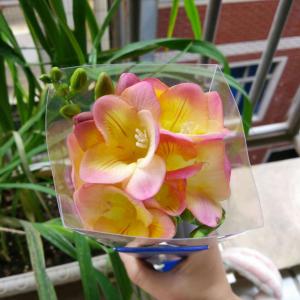








3
0
Lin吃货:@sunnyzou 没办法,长得相当不对称,因为没什么太阳晒得到,那叶子跟葱一样~还是剪下来比较好看
sunnyzou:我都舍不得剪下来!
文章
权问薇
2018年03月28日


一、清盛锦的扦插繁殖
1、扦插的时间
清盛锦的繁殖时间最好是选择在每年的生长季,即春天和秋天这两季进行,因为这两个季节的温度正好适合于清盛锦进行繁殖。
2、插叶的选择
插叶需要选择没有病虫害而且比较健壮的枝叶才可以。剪下来枝叶之后需要稍微晾晾,然后等待下一个步骤。
3、土壤
土壤选择沙土或者蛭石,这样透气性和排水性比较好。
4、扦插操作
将晾后的枝叶插进准备好的土壤中,然后放在阴凉的地方养殖,保持有一定的湿润度,很快就可以生根了。一般叶插的植物形成完整的植株还是比较慢的,所以需要有一定耐心。
二、扦插后的养护
1、土壤
插叶慢慢生根之后,其实可以移植到别的盆里,这时候要求的土壤需要疏松,肥沃一点的土壤更好一点。

2、浇水
在冬天的时候,如果清盛锦的生长温度在十二摄氏度以上,这时候可以对清盛锦进行浇水处理,这样清盛锦还会继续生长。如果冬天温度达不到这个温度,就不需要再浇水了,保持土壤的干燥,这样清盛锦可以耐一定的低温。春天和秋天是清盛锦生长时期,这个时候一定要浇水比较充足,时刻保持土壤有水分,如果空气太干燥可以适当的洒点水,这样有利于清盛锦的生长。
3、施肥
一般每隔半个多月的时间就要对清盛锦施一次肥,需要施薄肥,但是要防止肥料施到叶上。
4、光照
清盛锦是喜欢阳光的植物,但是在夏天比较热的时候会出现休眠的状态,所以一定不要对清盛锦进行强光照射。其他三个季节光照不是很强,所以可以一直进行太阳照射。
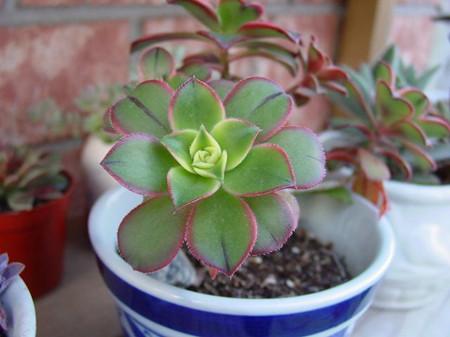
0
0



